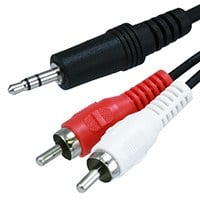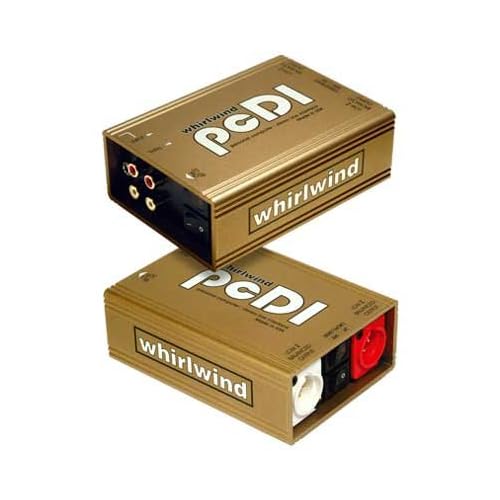You are using an out of date browser. It may not display this or other websites correctly.
You should upgrade or use an alternative browser.
You should upgrade or use an alternative browser.
3.5mm to 2x XLR Adapter
- Thread starterEdrick
- Start date
Here's how I'd do it.
Tip: to pin 2 of "Left" XLR-M
Ring: to pin 2 of "Right" XLR-M
Sleeve: to pin 1 & 3 of BOTH XLR-Ms.
See this document: Insert Cable.pdf, and change the 1/4" TRS to 3.5mm and both XLRs to male.
However, the whole thing is a pain in the behind! I'd rather buy a 3.5mm to 2xRCA cable:

For only $0.65 each when QTY 50+ purchased - 3.5mm Stereo Plug/2 RCA Plug cable - 6ft | 3.5mm/RCA Audio Cables , and then make two XLR to RCA adapters.
Edit: OR just buy the contraption for $6.95:

Soldering tiny wires inside 1/8", 3.5mm, TA-, Lemo, etc. connectors is always best left to others, IMHO.
Tip: to pin 2 of "Left" XLR-M
Ring: to pin 2 of "Right" XLR-M
Sleeve: to pin 1 & 3 of BOTH XLR-Ms.
See this document: Insert Cable.pdf, and change the 1/4" TRS to 3.5mm and both XLRs to male.
However, the whole thing is a pain in the behind! I'd rather buy a 3.5mm to 2xRCA cable:

For only $0.65 each when QTY 50+ purchased - 3.5mm Stereo Plug/2 RCA Plug cable - 6ft | 3.5mm/RCA Audio Cables , and then make two XLR to RCA adapters.
Edit: OR just buy the contraption for $6.95:

Soldering tiny wires inside 1/8", 3.5mm, TA-, Lemo, etc. connectors is always best left to others, IMHO.
Last edited:
hmm I do suppose that's the best idea I was just looking for a project to work on I recently acquired a decent sized amount of electronics gear. 5 Solder Irons, Wire Cutters & Strippers, Cases of LEDs Resistors Capacitors and Chips. LED Displays. Screw Drivers Solder Multi meter etc...
None of the adapters will do what you really need to do. They should work, but your could damage your computer soundcard. Do a search for Mic Level and Line Level, that should give you the "why" to the answer.
You need to buy a direct box to change the signal from line level to mic level. I would suggest the whirlwind PCDI for this...

You need to buy a direct box to change the signal from line level to mic level. I would suggest the whirlwind PCDI for this...

Last edited by a moderator:
jkowtko
Well-Known Member
Every standard sound console can take mic vs line inputs. The need for a DI box is when your source is a long distance from the board (i.e. on stage) and you want to run balance lines to the board to protect against noise pickup. For that purpose a DI box will be useful.
If your PC or laptop is sitting next to the sound console, just use 1/8" to 2 1/4" TS jacks and you should be fine.
If your PC or laptop is sitting next to the sound console, just use 1/8" to 2 1/4" TS jacks and you should be fine.
Every standard sound console can take mic vs line inputs. The need for a DI box is when your source is a long distance from the board (i.e. on stage) and you want to run balance lines to the board to protect against noise pickup. For that purpose a DI box will be useful.
If your PC or laptop is sitting next to the sound console, just use 1/8" to 2 1/4" TS jacks and you should be fine.
I sort of, but not entirely agree with your statement. Every console I've run into has been a little different. Our Mackie 1604 has mic and line inputs on every channel, but the mic inputs are XLR's and the line inputs are 1/4" TRS. The line inputs do not allow phantom power to factor into the gain here. Our Soundcraft k2 has XLR and 1/4" TRS inputs, but the operator has to select the gain range for a mic or line level signal using a button found by the gain knob on every single channel strip. Meanwhile, our Yamaha LS9 simply doesn't have line inputs. Everything has to be brought in via XLR after being stepped down to a mic-level signal. Different consoles handle the signals differently, and some not at all.
Before you go soldering the cords, make certain that you're making the right thing. If the consoles have line level inputs for 1/4" TRS connectors, make sure you use those even if there are also XLR inputs as well. The 1/4" TRS line inputs are usually setup such that they do not allow +48v phantom power onto those inputs. You definitely do not want to accidentally send +48v to an MP3 player. Depending on the MP3 player, you could just have a really loud signal that's unusable and clipped out, but you could also have an accidental hand grenade.
howlingwolf487
Active Member
I completely agree with Kyle. The DI doesn't just change the connector type, mind you, it (1) balances the unbalanced line so that you can make longer runs without signal degredation and (2) converts the high-impedance into a low-impeance (600ohms or so) so that a mic input can be matched to it.None of the adapters will do what you really need to do. They should work, but your could damage your computer soundcard. Do a search for Mic Level and Line Level, that should give you the "why" to the answer.
You need to buy a direct box to change the signal from line level to mic level. I would suggest the whirlwind PCDI for this...
There's more to making connections than the connector. That being said, if you need a short patch cable for use back at the console, I think such an adapter as the OP proposed above would be fine. Keep the length to a reasonable 5ft. or so.
Last edited by a moderator:
Anonymous067
Active Member
Not to hijack but we have had the same problem with the noise from a laptop (apple macbook).
We have DI boxes.
My question is if we hook a 1/8" to 1/4" adapter and then used two DI's (one for left and one for right) would it get rid of the hum(as it is rather annoying)?
howlingwolf487
Active Member
It should get rid of the hum, yes. Just make sure yousplit the unbalanced signal properly (single 1/8" to dual TS plugs). Left Channel = Pin 2 (+) and Pin 1 (Shield/-); Right Channel = Pin 3 (+) and Pin 1 (Shield/-). The positive goes to the tip of the TS plug and the Shield/- goes to the Sleeve of the TS plug.My question is if we hook a 1/8" to 1/4" adapter and then used two DI's (one for left and one for right) would it get rid of the hum(as it is rather annoying)?
Purpose-built DIs like the Whirlwind PCDI are made specifically for interfacing unbalanced "consumer-level" gear (-10dBV) with balanced "professional-level" gear (+4dBu). Whirlwind's unit has RCA I/O, 1/8" Input, and separate L&R XLR outputs. There are also ground lifts and 20dB pads for each channel as well as a Sum-to-Mono switch for those times when your channel count is running low. ProCo has some similar devices, too.
Essentially, the PCDI (and simiar devices) are 2 DIs in one case but have bee tailored to a specific use. 2 DIs would work, but I'm a big fan of having less adapters in the signal chain.
Last edited:
TimmyP1955
Well-Known Member
The LS9's inputs are speced to handle both mic and line...
Correct.
Back the head amp gain all the way down, and the PFL signal level will be well below clipping. If you find that you have to run the fader lower than you'd like, use the attenuation control in the channel EQ section to back the signal level down to whatever suits you.
It should get rid of the hum, yes. Just make sure yousplit the unbalanced signal properly (single 1/8" to dual TS plugs). Left Channel = Pin 2 (+) and Pin 1 (Shield/-); Right Channel = Pin 3 (+) and Pin 1 (Shield/-). The positive goes to the tip of the TS plug and the Shield/- goes to the Sleeve of the TS plug.
Huh?
In a stereo breakout, tip is left, ring is right and sleeve is the common ground. There are no pins in a jack connector and you certainly don't want to be wiring this with XLRs
The PCDI is in many ways a marketing thing. A normal stereo DI with the right adapters is equivalent in performance.
Yes a DI should eliminate ground loop generated noise on the audio line/s.
howlingwolf487
Active Member
Yes, that is what I tried (apparently unsuccesssfully) to get across. The Tip and Shield would go to the first XLR, Pins 2 and 1, respectively. The Ring and Shield would go to the other XLR and go to Pins 3 and 1, respectively.
This wouldn't be any different than the cable pictured in this post. If I am incorrect, I will gladly look to be show how to unbalance an XLR connector "properly" (I know, I know...it's a travesty to do that). The right way is to use a direct box of some sort to transformer-isolate the connections.
The PCDI is in many ways a marketing thing. A normal stereo DI with the right adapters is equivalent in performance.
Yes, it is marketed towards those needing a DI specifically for use with stereo, unbalanced inputs that are on consumer-grade connectors, and that need to be run for long distances. For me, an adapter is just another place for something to go wrong; I avoid them when possible.
Respectfully, no. Ring and shield would also go to pins 2 and 1 respectively. Otherwise you've introduced a polarity reversal on the right channel. In both cases, you want to link the shield to both pins 1 and 3 to deal with the various balancing options on the input.
howlingwolf487
Active Member
Ah, I see. Silly differentially-balanced inputs
That's why I use a DI to take care of the balancing.
Thanks for the info - don't know what I was (or wasn't) thinking about.
bishopthomas
Well-Known Member
howlingwolf487 said:For me, an adapter is just another place for something to go wrong; I avoid them when possible.
Of course, but often a necessary part of interfacing gear that doesn't have every connector option known to man. Sorry, but Apple doesn't put XLR outs on an iPod and most consoles don't have 1/8" inputs. If you buy (or make) quality cables/adapters, don't mistreat them, and know which one to grab out of the kit you shouldn't have any problems. I've had some adapters and cables for over 10 years and they still work perfectly.
I have used the cable the original poster is talking about very often with consoles that do not have 1/4" inputs. I use it all the time with an LS9 and M7CL and it works just like it should. iPods, laptops, walkman CD players - as long as it's close to the console you usually will not need a DI. If it's run from stage then of course...
Similar threads
- Replies
- 11
- Views
- 1K
- Replies
- 6
- Views
- 3K
- Replies
- 2
- Views
- 1K
Users who are viewing this thread
Total: 1 (members: 0, guests: 1)


